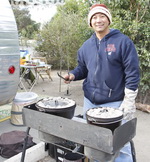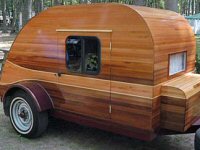Experienced Epoxy users... CPES?
19 posts
• Page 1 of 2 • 1, 2
Experienced Epoxy users... CPES?
A recent thread about different brands of epoxy brought up a burning question about CPES. Recently, I mixed up a batch of the West System epoxy resin, and diluted it with mineral spirits. Thus, making a batch of my own version of the CPES product by Rot Doctor. The consistency was not as thin as the CPES, and penetrated well for my application. CPES is not inexpensive, and seems to disappear as quickly when applying it. Several coats until saturated could eventually use up the expensive supply of CPES in a blink of an eye.
My question: Is the CPES product superior for the intended use, vs. mixing your own, as I have done?
I have used the CPES product once. Many people have stated using CPES while building. It just seems easier to have one product than to special order CPES directly from Rot Doctor. I could purchase epoxy within driving distance, and not have to pay the extra shipping for CPES.
My question: Is the CPES product superior for the intended use, vs. mixing your own, as I have done?
I have used the CPES product once. Many people have stated using CPES while building. It just seems easier to have one product than to special order CPES directly from Rot Doctor. I could purchase epoxy within driving distance, and not have to pay the extra shipping for CPES.
Why just dance, when you can Salsa!
Cliff & Vanessa
Cliff & Vanessa
-

cuyeda - Platinum Donating Member
- Posts: 1924
- Images: 17
- Joined: Fri Sep 22, 2006 12:09 am
- Location: California, Long Beach
I'll throw in my heretical view: any solvent in epoxy is a bad idea if it is for protecting good wood. Your aim should be to create an epoxy-rich layer that will be as nearly waterproof as possible. If there is a solvent in it, it will leave voids when it evaporates, creating a less waterproof layer, offering less protection to the wood.
If the use of the epoxy is to reinforce rotted or softened wood, which I understand was the purpose of CPES, then solvents may be a good idea - I've no experience of that so I don't have an opinion.
Epoxy is not paint, and however much anyone reveres their grandfather's instruction to get a coating to soak a long way into wood, the mechanics are different. Soaking epoxy into end-grain, for example, is primarily a one-shot deal - you must continually feed the same mix of epoxy into the end grain until it stops being absorbed. Typically, this means applying epoxy to the end grain maybe six times in ten minutes and only stopping when the epoxy starts to harden.
If the use of the epoxy is to reinforce rotted or softened wood, which I understand was the purpose of CPES, then solvents may be a good idea - I've no experience of that so I don't have an opinion.
Epoxy is not paint, and however much anyone reveres their grandfather's instruction to get a coating to soak a long way into wood, the mechanics are different. Soaking epoxy into end-grain, for example, is primarily a one-shot deal - you must continually feed the same mix of epoxy into the end grain until it stops being absorbed. Typically, this means applying epoxy to the end grain maybe six times in ten minutes and only stopping when the epoxy starts to harden.
-

angib - 5000 Club

- Posts: 5783
- Images: 231
- Joined: Fri Apr 30, 2004 2:04 pm
- Location: (Olde) England







